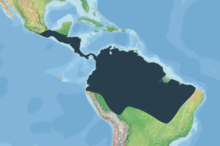Our website is made possible by displaying online advertisements to our visitors.
Please consider supporting us by disabling your ad blocker.
Spectacled caiman
| Spectacled caiman | |
|---|---|

| |
| In Llanos, Venezuela | |
| Scientific classification | |
| Domain: | Eukaryota |
| Kingdom: | Animalia |
| Phylum: | Chordata |
| Class: | Reptilia |
| Clade: | Archosauromorpha |
| Clade: | Archosauriformes |
| Order: | Crocodilia |
| Family: | Alligatoridae |
| Subfamily: | Caimaninae |
| Clade: | Jacarea |
| Genus: | Caiman |
| Species: | C. crocodilus
|
| Binomial name | |
| Caiman crocodilus | |

| |
| Native range (black) | |
| Synonyms[5] | |
| |
The spectacled caiman (Caiman crocodilus), also known as the white caiman,[6] common caiman,[7] and speckled caiman,[8] is a crocodilian in the family Alligatoridae. It is brownish-, greenish-, or yellowish-gray colored and has a spectacle-like ridge between its eyes, which is where its common name come from. It grows to a length of 1.4–2.5 m (4 ft 7 in – 8 ft 2 in) and a weight of 7–40 kg (15–88 lb), with males being both longer and heavier than females. Its diet varies seasonally, commonly consisting of crabs, fish, small mammals, amphibians and snails. Breeding occurs from May to August and 14–40 eggs are laid in July and August. This crocodilian has a large range and population; it is native to much of Latin America, and has been introduced to the United States, Cuba, and Puerto Rico.
- ^ Rio, Jonathan P.; Mannion, Philip D. (6 September 2021). "Phylogenetic analysis of a new morphological dataset elucidates the evolutionary history of Crocodylia and resolves the long-standing gharial problem". PeerJ. 9: e12094. doi:10.7717/peerj.12094. PMC 8428266. PMID 34567843.
- ^ Balaguera-Reina, S.A.; Velasco, A. (2019). "Caiman crocodilus". IUCN Red List of Threatened Species. 2019: e.T46584A3009688. doi:10.2305/IUCN.UK.2019-1.RLTS.T46584A3009688.en. Retrieved 19 November 2021.
- ^ "Appendices | CITES". cites.org. Retrieved 14 January 2022.
- ^ Giovanne M. Cidade; Daniel Fortier; Ascanio Daniel Rincón; Annie Schmaltz Hsiou (2019). "Taxonomic review of two fossil crocodylians from the Cenozoic of South America and its implications for the crocodylian fauna of the continent". Zootaxa. 4656 (3): 475–486. doi:10.11646/zootaxa.4656.3.5. PMID 31716812. S2CID 202012442.
- ^ "Caiman crocodilus crocodilus". CITES. Archived from the original on 30 March 2019. Retrieved 30 March 2019.
- ^ Franzen, Margaret Anne (2005). Huaorani resource use in the Ecuadorian Amazon. University of California, Davis. p. 181. Retrieved 3 April 2019.
- ^ "ITIS Standard Report Page: Caiman crocodilus". Integrated Taxonomic Information System. Retrieved 28 March 2019.
- ^ Del Claro, Kleber; Oliveira, Paulo S.; Rico-Gray, Victor (11 May 2009). Tropical Biology and Conservation Management. EOLSS Publications. pp. 273–274. ISBN 978-1848262812. Retrieved 5 April 2019.
Previous Page Next Page



